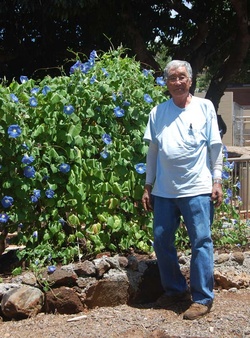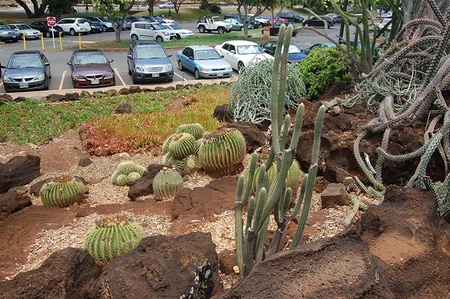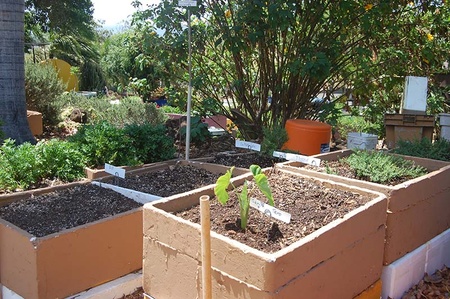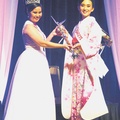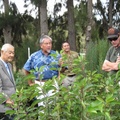Frequent visitors to Kapi‘olani Community College have probably seen the expansive garden of giant succulents growing along the front walkway of the main Diamond Head Road parking lot.
Further up, fronting the ‘Ilima Building, are an herb garden and a relatively new addition to the campus, the “Po-e-tree.” Benches placed nearby make these gardens peaceful rest stops for students and the community alike. The person most responsible for these gifts is 88-year-old Moriso Teraoka, a 100th Infantry Battalion veteran and a perennial part-time student at KCC.
After the war, Teraoka was hired as an apprentice machinist at the Pearl Harbor Naval Shipyard. He worked his way up to a journeyman machinist and eventually became the first person of Japanese ancestry to work in a supervisory capacity at the shipyard, with responsibility for the timely completion of repairs to the nuclear propulsion power plant on submarines. He retired in 1985 as a nuclear ship superintendent.
Teraoka then began taking classes at KCC, where he earned an associate’s degree in food service. He also took several writing classes and was a student reporter and photographer for Kapi‘o, KCC’s newspaper, for 10 years.
It was Teraoka’s “What if?” attitude that led to the creation of the succulent and cacti garden and, later, the herb garden and the Po-e-tree on the KCC campus.
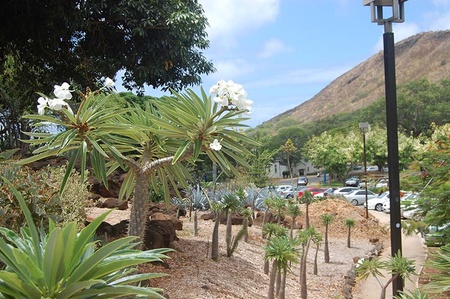
Moriso Teraoka's "What if" attitude led to the creation of the succulent and cacti garden on the Kapi‘olani Community College campus.
In 1988, Teraoka asked school officials for permission to clear and landscape the area fronting Parking Lot B (facing Diamond Head Road).
“When I first started out as a student, part of [KCC] was here [at Diamond Head] and the other part was on Pensacola [Street]. I came here for American history and asked myself, ‘What if I started a garden here?’ I was a collector of succulent plants and the school gave me permission to start a garden,” he recalled.
With the help of friends and other volunteers, the garden has expanded to the area fronting Parking Lot A on the Diamond Head side of the campus, and beyond. Teraoka estimates the area to be about 820 feet wide (about the length of two-and-a-quarter football fields) and 50 to 100 feet deep.
In recognition of Teraoka’s volunteer efforts, he was presented a service award by then-KCC Chancellor John Morton in 1989. The school also received beautification awards from the Outdoor Circle in 1990 and 1998. The campus community and the neighborhood recognized Teraoka’s efforts, as well.
In 1998, Roy Onomura, then-International Student Club president and Board of Student Activities chair, organized a group of volunteers to spend a Saturday morning clearing weeds from the garden. The event, called “Cactus and Coffee Garden Clean Up,” continues to be held. On one designated Saturday every semester, KCC students and faculty, McKinley High School students, and neighborhood residents turn out to help clear away the weeds.
In 1989, Teraoka began hearing that “what if” voice again. This time, he began growing herbs for the culinary arts students.
“I found out that the culinary school used to buy herbs and I asked myself, ‘Why not start a garden for the students to come and learn?’” More than to supply the culinary classes, the herb garden is meant to help the students recognize the various herbs. Although he is offered many exotic herbs from a variety of sources, Teraoka plants mainly the basics—basil (sweet and Thai), Chinese parsley, rosemary, sage, and thyme—and a few other not-so-common herbs: cilantro, curry plant, dill, khafir lime leaves, lemongrass, and even asparagus.
In 2006, Sam Camp, a retiree of the Hawai‘i Department of Agriculture, began helping Teraoka maintain the gardens. “I can’t do the heavy lifting anymore, so Sam’s taken over those duties,” said Teraoka. The pair has also enlisted the help of student Lesley Goo.
Although Teraoka spends a lot of his time in the garden, he still makes time to take classes at KCC. In fact, he drives to the campus every day, Monday through Friday, and even on Saturdays to feed the birds. When he’s not collecting succulent plants or tending to his KCC gardens, there’s a good chance that Teraoka is pursuing another of his passions.
“I love writing,” says Teraoka, who has taken writing classes, mainly poetry writing, for the last three years. He proudly brings out his chapbooks—small collections of his poetry—and points out his favorite poems. Several of his poems were published earlier this year in Bamboo Ridge’s milestone Issue #100.
The idea for the “Po-e-tree” stemmed from Teraoka’s love of writing and the many poetry classes he has taken.
“I kept thinking, ‘What if, what if?’” says Teraoka. “There’s lots of visitors to the campus from Japan and elsewhere, as well as those from the farmer’s market [on Saturday mornings]. So I kept wondering, ‘What if?’ and that’s how it got started.”
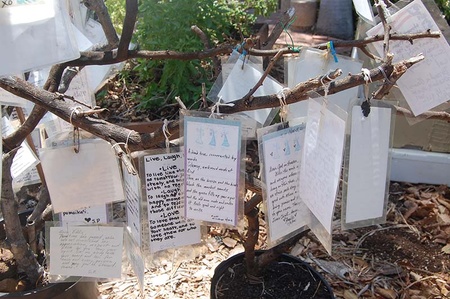
Moriso Teraoka's "Po-e-tree" brings out the inner writer in visitors to the Kapi‘olani Community College campus.
Passersby stop at the small plastic box near the tree, where instructions printed in English and Japanese explain the tree’s purpose and encourage people to use the furnished paper and Sharpie pen to write a poem or haiku and place it back in the box. Every day, Teraoka takes the poems out of the box, laminates them and hangs them on the tree for all to enjoy.
A visitor from Kona left the first submission. Others have been left by visitors from Tökyö, Ösaka, and Köbe in Japan; from London and even visiting doctors from Maryland. Faculty members have written poems about the tree itself. The Po-e-tree is so popular that the branches are running out of space. Teraoka accepts all submissions and does not rotate any of the entries. However, instead of laminating each poem separately, he now puts several together and then laminates them to save space. The popularity of Teraoka’s Po-e-tree even inspired a visiting professor to start one at her Mainland school.
But Teraoka has one other passion that he continues to work at—the desire to speak Japanese fluently. He learned the basics as a youth attending Japanese language school and has been working to improve his proficiency. He says he surprised himself recently while conversing with a visitor from Japan. Although his Japanese was far from perfect, he was able to express himself. “I’ll get there one day,” he said with a smile.
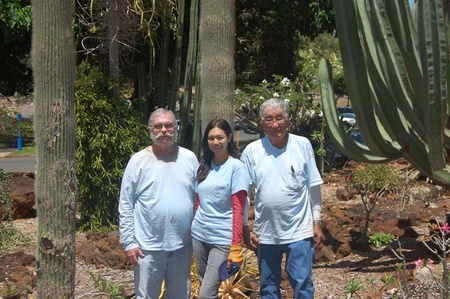
Volunteer Moriso Teraoka (right) with fellow volunteer Sam Camp and student helper Lesley Goo in a section of the cacti and succulent garden.
* This article was originally published in the Hawaii Herald on December 21, 2012.
© 2012 Gwen Battad Ishikawa


